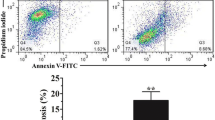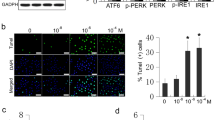Abstract
It is well known that glucocorticoid (GC)-induced bone loss is caused primarily by hypofunction and apoptosis of osteoblasts. However, the precise molecular events underlying the effect of GC on osteoblast apoptosis are not fully understood. Recent studies implicated an important role of E4BP4 in the regulation of osteoblast apoptosis and differentiation. Furthermore, E4BP4 is a GC-regulated gene required for GC-induced apoptosis in many cells. Therefore, we hypothesize that E4BP4 may be implicated in the process of GC-induced osteoblast apoptosis. Western blot, reverse-transcription-PCR, flow cytometry, and Hoechst 33258 staining were employed to investigate the role of E4BP4 in dexamethasone (DEX)-induced osteoblast apoptosis. We found that the expression of E4BP4 is significantly up-regulated in osteoblasts exposed to DEX. Furthermore, the depletion of E4BP4 significantly decreased DEX-induced osteoblast apoptosis. In addition, E4BP4 plays a crucial role in GC-evoked apoptosis of osteoblasts by enabling induction of Bim. On the basis of these results above, we can draw the conclusion that E4BP4 may contribute to the process of DEX-induced osteoblast apoptosis.




Similar content being viewed by others
References
Kim HJ, Zhao H, Kitaura H, Bhattacharyya S, Brewer JA, Muglia LJ, Ross FP, Teitelbaum SL (2006) Glucocorticoids suppress bone formation via the osteoclast. J Clin Investig 116:2152–2160
Osella G, Ventura M, Ardito A, Allasino B, Termine A, Saba L, Vitetta R, Terzolo M, Angeli A (2012) Cortisol secretion, bone health, and bone loss: a cross-sectional and prospective study in normal non-osteoporotic women in the early postmenopausal period. Eur J Endocrinol 166:855–860
Khan YK, Kalaaji AN, Clarke BL (2008) Glucocorticoid-induced osteoporosis in dermatologic practice: a review. J Drugs Dermatol 7:1053–1059
van Staa TP (2006) The pathogenesis, epidemiology and management of glucocorticoid-induced osteoporosis. Calcif Tissue Int 79:129–137
Usui M, Yoshida Y, Tsuji K, Oikawa K, Miyazono K, Ishikawa I, Yamamoto T, Nifuji A, Noda M (2004) Tob deficiency superenhances osteoblastic activity after ovariectomy to block estrogen deficiency-induced osteoporosis. Proc Natl Acad Sci USA 101:6653–6658
Martin-Millan M, Almeida M, Ambrogini E, Han L, Zhao H, Weinstein RS, Jilka RL, O’Brien CA, Manolagas SC (2010) The estrogen receptor-alpha in osteoclasts mediates the protective effects of estrogens on cancellous but not cortical bone. Mol Endocrinol 24:323–334
Horsch K, de Wet H, Schuurmans MM, Allie-Reid F, Cato AC, Cunningham J, Burrin JM, Hough FS, Hulley PA (2007) Mitogen-activated protein kinase phosphatase 1/dual specificity phosphatase 1 mediates glucocorticoid inhibition of osteoblast proliferation. Mol Endocrinol 21:2929–2940
Porter RM, Huckle WR, Goldstein AS (2003) Effect of dexamethasone withdrawal on osteoblastic differentiation of bone marrow stromal cells. J Cell Biochem 90:13–22
Conradie MM, de Wet H, Kotze DD, Burrin JM, Hough FS, Hulley PA (2007) Vanadate prevents glucocorticoid-induced apoptosis of osteoblasts in vitro and osteocytes in vivo. J Endocrinol 195:229–240
Weinstein RS (2001) Glucocorticoid-induced osteoporosis. Rev Endocr Metab Disord 2:65–73
Weinstein RS, Jilka RL, Parfitt AM, Manolagas SC (1998) Inhibition of osteoblastogenesis and promotion of apoptosis of osteoblasts and osteocytes by glucocorticoids. Potential mechanisms of their deleterious effects on bone. J Clin Investig 102:274–282
Ozkurt IC, Pirih FQ, Tetradis S (2004) Parathyroid hormone induces E4bp4 messenger ribonucleic acid expression primarily through cyclic adenosine 3′,5′-monophosphate signaling in osteoblasts. Endocrinology 145:3696–3703
Ozkurt IC, Tetradis S (2003) Parathyroid hormone-induced E4BP4/NFIL3 down-regulates transcription in osteoblasts. J Biol Chem 278:26803–26809
Cowell IG (2002) E4BP4/NFIL3, a PAR-related bZIP factor with many roles. BioEssays 24:1023–1029
Silvestris F, Cafforio P, De Matteo M, Calvani N, Frassanito MA, Dammacco F (2008) Negative regulation of the osteoblast function in multiple myeloma through the repressor gene E4BP4 activated by malignant plasma cells. Clin Cancer Res 14:6081–6091
Male V, Nisoli I, Gascoyne DM, Brady HJ (2012) E4BP4: an unexpected player in the immune response. Trends Immunol 33:98–102
Beach JA, Nary LJ, Hirakawa Y, Holland E, Hovanessian R, Medh RD (2011) E4BP4 facilitates glucocorticoid-evoked apoptosis of human leukemic CEM cells via upregulation of Bim. J Mol Signal 6:13
Gohel A, McCarthy MB, Gronowicz G (1999) Estrogen prevents glucocorticoid-induced apoptosis in osteoblasts in vivo and in vitro. Endocrinology 140:5339–5347
Bakker AD, Klein-Nulend J (2012) Osteoblast isolation from murine calvaria and long bones. Methods Mol Biol 816:19–29
Guo L, Xu J, Qi J, Zhang L, Wang J, Liang J, Qian N, Zhou H, Wei L, Deng L (2013) MicroRNA-17-92a upregulation by estrogen leads to Bim targeting and inhibition of osteoblast apoptosis. J Cell Sci 126:978–988
Dong J, Cui X, Jiang Z, Sun J (2013) MicroRNA-23a modulates tumor necrosis factor-alpha-induced osteoblasts apoptosis by directly targeting Fas. J Cell Biochem 114:2738–2745
Walsh S, Jordan GR, Jefferiss C, Stewart K, Beresford JN (2001) High concentrations of dexamethasone suppress the proliferation but not the differentiation or further maturation of human osteoblast precursors in vitro: relevance to glucocorticoid-induced osteoporosis. Rheumatology (Oxf) 40:74–83
Tong X, Muchnik M, Chen Z, Patel M, Wu N, Joshi S, Rui L, Lazar MA, Yin L (2010) Transcriptional repressor E4-binding protein 4 (E4BP4) regulates metabolic hormone fibroblast growth factor 21 (FGF21) during circadian cycles and feeding. J Biol Chem 285:36401–36409
Wallace AD, Wheeler TT, Young DA (1997) Inducibility of E4BP4 suggests a novel mechanism of negative gene regulation by glucocorticoids. Biochem Biophys Res Commun 232:403–406
Marani M, Tenev T, Hancock D, Downward J, Lemoine NR (2002) Identification of novel isoforms of the BH3 domain protein Bim which directly activate Bax to trigger apoptosis. Mol Cell Biol 22:3577–3589
Espina B, Liang M, Russell RG, Hulley PA (2008) Regulation of Bim in glucocorticoid-mediated osteoblast apoptosis. J Cell Physiol 215:488–496
Liang M, Russell G, Hulley PA (2008) Bim, Bak, and Bax regulate osteoblast survival. J Bone Miner Res 23:610–620
Cowell IG, Skinner A, Hurst HC (1992) Transcriptional repression by a novel member of the bZIP family of transcription factors. Mol Cell Biol 12:3070–3077
Benito A, Gutierrez O, Pipaon C, Real PJ, Gachon F, Ritchie AE, Fernandez-Luna JL (2006) A novel role for proline- and acid-rich basic region leucine zipper (PAR bZIP) proteins in the transcriptional regulation of a BH3-only proapoptotic gene. J Biol Chem 281:38351–38357
Ritchie A, Gutierrez O, Fernandez-Luna JL (2009) PAR bZIP-bik is a novel transcriptional pathway that mediates oxidative stress-induced apoptosis in fibroblasts. Cell Death Differ 16:838–846
Falkenstein E, Tillmann HC, Christ M, Feuring M, Wehling M (2000) Multiple actions of steroid hormones—a focus on rapid, nongenomic effects. Pharmacol Rev 52:513–556
Thompson EB (2008) Stepping stones in the path of glucocorticoid-driven apoptosis of lymphoid cells. Acta Biochim Biophys Sin (Shanghai) 40:595–600
Webb MS, Miller AL, Johnson BH, Fofanov Y, Li T, Wood TG, Thompson EB (2003) Gene networks in glucocorticoid-evoked apoptosis of leukemic cells. J Steroid Biochem Mol Biol 85:183–193
Thompson EB, Johnson BH (2003) Regulation of a distinctive set of genes in glucocorticoid-evoked apoptosis in CEM human lymphoid cells. Recent Prog Horm Res 58:175–197
Acknowledgments
The authors thank Dong Jun, PhD, for advice and discussion. Supported in part by the National Natural Science Foundation of China (Grant numbers 81271236).
Author information
Authors and Affiliations
Corresponding author
Additional information
Fangjing Chen and Li Zhang have contributed equally to this article.
F. Chen, L. Zhang, Y. Ouyang, H. Guan, Q. Liu and B. Ni declare that they have no conflict of interest.
Rights and permissions
About this article
Cite this article
Chen, F., Zhang, L., OuYang, Y. et al. Glucocorticoid Induced Osteoblast Apoptosis by Increasing E4BP4 Expression via Up-regulation of Bim. Calcif Tissue Int 94, 640–647 (2014). https://doi.org/10.1007/s00223-014-9847-6
Received:
Accepted:
Published:
Issue Date:
DOI: https://doi.org/10.1007/s00223-014-9847-6




